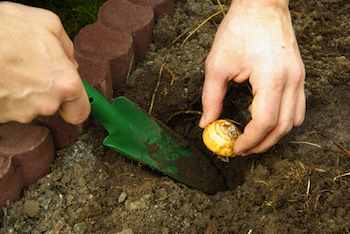By Sean Conway

'Fall bulbs' produce flowers that bloom in the spring, and the ideal time to plant them is six weeks before the first frost.
Once the cool weather arrives, and the days start getting shorter, keeping the garden looking it's best takes a lot more work. Spent perennials need cutting back, deciduous shrubs and trees start shedding their leaves, there is the ongoing cleanup in the vegetable garden, and for some reason the weeds on my property seem to grow even faster than they did all summer.
And now that the evening temperatures have dropped low enough to warrant wearing a sweater, it's time to think ahead to spring by planting fall bulbs.
In gardening circles, spring blooming bulbs are referred to as fall bulbs -- a confusing moniker for those new to gardening, and just as confusing as summer blooming bulbs being referred to as spring bulbs.
At first glance it seems not to make sense, but for gardeners, planting time trumps blooming time; having a good garden is predicated on timely chores and thinking ahead.
Most bulbs should be planted a good six weeks before frost. The reason is that bulbs form their roots in soil that is cool and moist. Once they have an established root system, they stay in a suspended state of animation throughout the winter months until soil temperatures begin to warm again. Long cold periods of six to 12 weeks followed by a slow period of warming signals the bulbs to bloom.
Planting bulbs in your garden is about as easy as gardening gets, and is a great way for first time gardeners to get started with gardening.
It is also the perfect way to start gardening with kids. Basically, you only need to dig a hole, place the bulb in it, cover the bulb with soil and wait for spring. Waiting, of course, is the hardest part.
Naturally, there are a few particulars that will help ensure success, but if you meet the meager requirements of most bulbs you can't go wrong.
First, most bulbs don't grow well in wet soil; avoid planting in areas where water accumulates, such as the bottom of a hill. There are exceptions, such as the spiky, blue-flowered Camassia, a beautiful bulb native to wet meadows of the Pacific Northwest.
Second, most bulbs (if not all) prefer to be planted in sunny areas. Some are more tolerant of shade than others, and since many will emerge and bloom early in spring before trees and shrubs have fully leafed out, most gardeners will have plenty of options for suitable planting locations.
The third thing to remember is not to plant your bulbs too deep. Bulbs come in various sizes, from the acorn sized crocus bulb to full sized daffodil bulbs, clusters of which are about the size of an average lemon.
A general rule of thumb is to plant two to three times as deep as the bulb is tall. This means most large daffodils and tulips will be planted about 6 inches deep, and most small bulbs like crocus about 3 to 4 inches deep. The depth is measured from the top of the soil to the top of the bulb.
Once the bulb is planted, your work is done. You needn't worry about fertilizing the bulbs the first year, as they have all the food they need stored in the bulb. After the bulbs bloom next spring, add some bulb fertilizer to the top of the soil and lightly scratch it in. Follow package directions for the correct amount to apply.
Bulbs are readily available now, and can be found in garden centers, through on-line bulb vendors, or in DIY stores. With a little advanced planning, and very little work, you will be rewarded with beautiful blooming bulbs early next spring.
Available at Amazon.com:
Trowel and Error: Over 700 Tips, Remedies and Shortcuts for the Gardener
Cut Your Energy Bills Now: 150 Smart Ways to Save Money & Make Your Home More Comfortable & Green
It's Easy Being Green: A Handbook for Earth-Friendly Living
Copyright © Cultivating Life by Sean Conway. All rights reserved.
AUTOS | HOBBIES | EDUCATION | FAMILY | FASHION | FOOD & RECIPES | HOME DECOR | RELATIONSHIPS | PARENTING | PETS | TRAVEL | WOMEN
Home & Garden - Crisp Weather Signals Time to Plant Bulbs